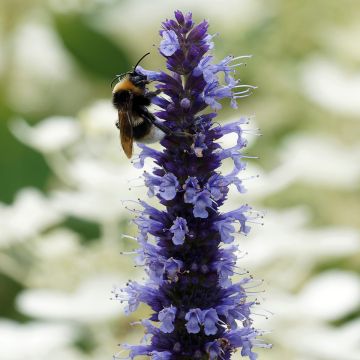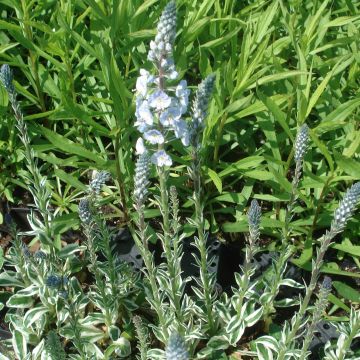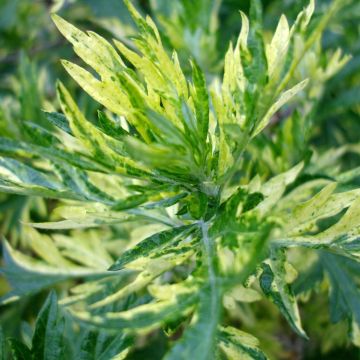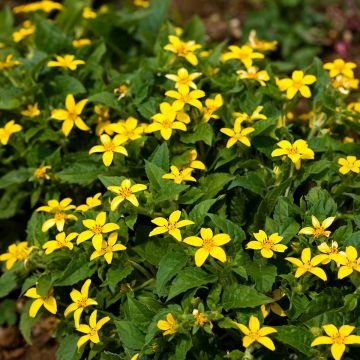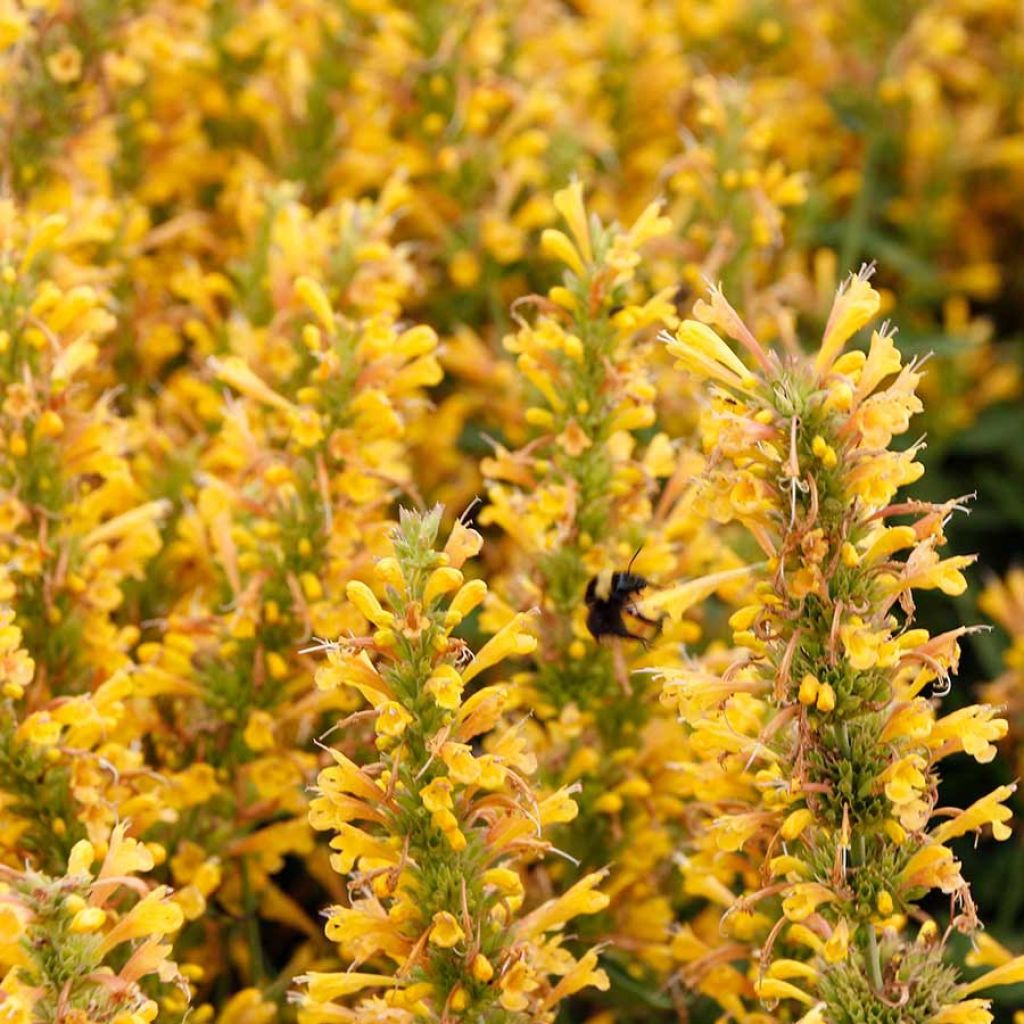

Agastache Poquito® Butter Yellow


Agastache Poquito® Butter Yellow
Agastache Poquito Butter Yellow
Agastache Poquito® Butter Yellow
Anise hyssop 'Butter Yellow'
This item cannot be shipped to the selected country
Delivery charge from €5.90
More information
Schedule delivery date,
and select date in basket
This plant carries a 12 months recovery warranty
More information
We guarantee the quality of our plants for a full growing cycle, and will replace at our expense any plant that fails to recover under normal climatic and planting conditions.
From €5.90 for pickup delivery and €6.90 for home delivery
Express home delivery from €8.90.
Does this plant fit my garden?
Set up your Plantfit profile →
Description
Agastache Poquito Butter Yellow is part of a line of particularly compact hybrid agastaches that are also known for their large flower spikes throughout summer. It is a compact and bushy variety with aromatic foliage that attracts butterflies and bees. This perennial and hardy variety will survive our winters in well-drained soil. Plant it in a sunny location in light soil that is not too dry in summer
Agastache Poquito Butter Yellow belongs to the Lamiaceae family, which is rich in plants producing essential oils. These substances protect them from both herbivorous animals and the sun's rays. This hybrid variety is no exception: its heart-shaped deciduous foliage is pleasantly aromatic.
Agastache Poquito Butter Yellow, developed in the USA, comes from a series of hybrids that are characterised by particularly compact clumps, even more so than the hybrid agastaches 'Kudos'. These varieties have also been selected for their flower spikes that do not fade over time. From June to September, the plant produces spikes in the shape of large "candles", above the green foliage. It forms a small, wide and dense clump, which will not exceed 30cm (12in) in height and 40cm (16in) in diameter. Each butter-yellow flower is nestled in a green calyx. The hardiness of this variety is not exceptional, especially in humid and cold climates in winter. Its nectar-rich flowering will attract bees and other pollinators for many weeks. The deciduous foliage is absent in winter. Agastaches are perennials with a rather short lifespan, and usually fade away after 3 to 5 years. Divide the clump regularly.
Agastache Poquito Butter Yellow appreciates full sun, tolerates light shade (its stems droop in very shady situations), and adapts to any garden soil that is not too chalky or too dry. Water potted plants regularly and they will reward you until autumn. It will look wonderful in a rocky bed or moist rockery with Erigeron karvinskianus, Sedum 'Angelina', Teucrium flavum, or even Delosperma 'Wheels of Wonder Orange'.
Report an error about the product description
Flowering
Foliage
Plant habit
Botanical data
Agastache
Poquito® Butter Yellow
Lamiaceae
Anise hyssop 'Butter Yellow'
Cultivar or hybrid
Other Agastache
Planting and care
It dislikes consistently wet soils in winter, as they can harm its hardiness and eventually kill it. In heavy soil, pure sand can be used to plant the stump without adding any soil. It requires a sunny and sheltered position, protected from severe frosts. During very harsh winters, cover the stumps with straw or dead leaves to create a thick mulch. The soil should be fertile, loose, and moist but well-drained, especially during the flowering period. The plant can tolerate temporary periods of drought, although they can still affect its flowering.
Planting period
Intended location
Care
This item has not been reviewed yet - be the first to leave a review about it.
Summer flowering perennials
Haven't found what you were looking for?
Hardiness is the lowest winter temperature a plant can endure without suffering serious damage or even dying. However, hardiness is affected by location (a sheltered area, such as a patio), protection (winter cover) and soil type (hardiness is improved by well-drained soil).

Photo Sharing Terms & Conditions
In order to encourage gardeners to interact and share their experiences, Promesse de fleurs offers various media enabling content to be uploaded onto its Site - in particular via the ‘Photo sharing’ module.
The User agrees to refrain from:
- Posting any content that is illegal, prejudicial, insulting, racist, inciteful to hatred, revisionist, contrary to public decency, that infringes on privacy or on the privacy rights of third parties, in particular the publicity rights of persons and goods, intellectual property rights, or the right to privacy.
- Submitting content on behalf of a third party;
- Impersonate the identity of a third party and/or publish any personal information about a third party;
In general, the User undertakes to refrain from any unethical behaviour.
All Content (in particular text, comments, files, images, photos, videos, creative works, etc.), which may be subject to property or intellectual property rights, image or other private rights, shall remain the property of the User, subject to the limited rights granted by the terms of the licence granted by Promesse de fleurs as stated below. Users are at liberty to publish or not to publish such Content on the Site, notably via the ‘Photo Sharing’ facility, and accept that this Content shall be made public and freely accessible, notably on the Internet.
Users further acknowledge, undertake to have ,and guarantee that they hold all necessary rights and permissions to publish such material on the Site, in particular with regard to the legislation in force pertaining to any privacy, property, intellectual property, image, or contractual rights, or rights of any other nature. By publishing such Content on the Site, Users acknowledge accepting full liability as publishers of the Content within the meaning of the law, and grant Promesse de fleurs, free of charge, an inclusive, worldwide licence for the said Content for the entire duration of its publication, including all reproduction, representation, up/downloading, displaying, performing, transmission, and storage rights.
Users also grant permission for their name to be linked to the Content and accept that this link may not always be made available.
By engaging in posting material, Users consent to their Content becoming automatically accessible on the Internet, in particular on other sites and/or blogs and/or web pages of the Promesse de fleurs site, including in particular social pages and the Promesse de fleurs catalogue.
Users may secure the removal of entrusted content free of charge by issuing a simple request via our contact form.
The flowering period indicated on our website applies to countries and regions located in USDA zone 8 (France, the United Kingdom, Ireland, the Netherlands, etc.)
It will vary according to where you live:
- In zones 9 to 10 (Italy, Spain, Greece, etc.), flowering will occur about 2 to 4 weeks earlier.
- In zones 6 to 7 (Germany, Poland, Slovenia, and lower mountainous regions), flowering will be delayed by 2 to 3 weeks.
- In zone 5 (Central Europe, Scandinavia), blooming will be delayed by 3 to 5 weeks.
In temperate climates, pruning of spring-flowering shrubs (forsythia, spireas, etc.) should be done just after flowering.
Pruning of summer-flowering shrubs (Indian Lilac, Perovskia, etc.) can be done in winter or spring.
In cold regions as well as with frost-sensitive plants, avoid pruning too early when severe frosts may still occur.
The planting period indicated on our website applies to countries and regions located in USDA zone 8 (France, United Kingdom, Ireland, Netherlands).
It will vary according to where you live:
- In Mediterranean zones (Marseille, Madrid, Milan, etc.), autumn and winter are the best planting periods.
- In continental zones (Strasbourg, Munich, Vienna, etc.), delay planting by 2 to 3 weeks in spring and bring it forward by 2 to 4 weeks in autumn.
- In mountainous regions (the Alps, Pyrenees, Carpathians, etc.), it is best to plant in late spring (May-June) or late summer (August-September).
The harvesting period indicated on our website applies to countries and regions in USDA zone 8 (France, England, Ireland, the Netherlands).
In colder areas (Scandinavia, Poland, Austria...) fruit and vegetable harvests are likely to be delayed by 3-4 weeks.
In warmer areas (Italy, Spain, Greece, etc.), harvesting will probably take place earlier, depending on weather conditions.
The sowing periods indicated on our website apply to countries and regions within USDA Zone 8 (France, UK, Ireland, Netherlands).
In colder areas (Scandinavia, Poland, Austria...), delay any outdoor sowing by 3-4 weeks, or sow under glass.
In warmer climes (Italy, Spain, Greece, etc.), bring outdoor sowing forward by a few weeks.





































